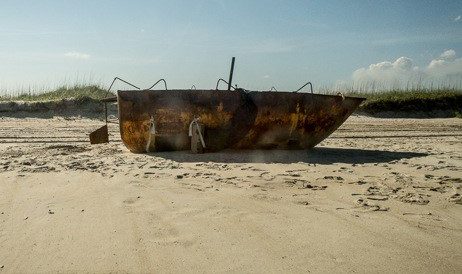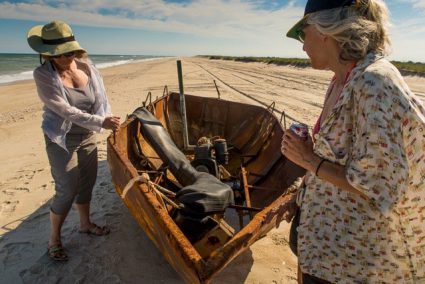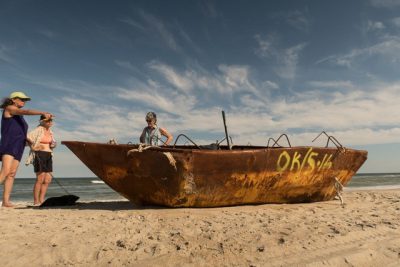
No one knows for sure when it first showed up. No one knew where it came from, but they thought they knew what it was, and they were right.
A small, rusty boat, apparently made from sections of steel drums, found in early June and since removed from a beach on South Core Banks in the Cape Lookout National Seashore, at one point carried refugees, probably fleeing Cuba.
Supporter Spotlight
“The Coast Guard did, in fact, interdict this boat at sea, somewhere off South Florida, in May 2016,” said Nathan Littlejohn, a public affairs officer at the Coast Guard’s 5th District headquarters in Portsmouth, Virginia.
Littlejohn had spent the better part of a week trying to track down information about the boat after being given a couple of pictures of it. He hit pay dirt when he talked to someone at the Coast Guard’s 7th District in Miami. It was in the “derelict vessel log.”
“What makes it so hard is that while it’s unusual to see something like this in North Carolina, it’s an everyday occurrence down there in South Florida,” Littlejohn said. “Sometimes they get dozens in a day.”
What happens, he said, is that when a patrol interdicts a vessel at sea, personnel take those aboard it off and begin the proceedings to send them back where they came from.
“We then mark it – the vessel had 5-16/OK painted on it – and set it adrift as ‘derelict,’” Littlejohn said. “This one just happened to end up in your national seashore. It most likely came up by way of the Gulf Stream.”
Supporter Spotlight
Tropical Storm Bonnie had passed nearby at the end of May, and could have sent it toward Core Banks. Those who saw the little boat called it “sad,” but also “beautiful.” Obviously, whoever set off in the boat had hope at one time; “Dios,” Spanish for God, was hand-painted on it.
The person who built the boat also knew at least a little about the sea, for he or she had attached inner tubes, filled with Styrofoam, as outriggers, to the vessel for stability. The tiller was made of rebar.

It also had an inboard engine, which is much quieter than an outboard and more fuel-efficient, better for avoiding detection and making a long journey across the Florida Straits without stopping. In Coast Guard parlance, it’s called a “chug.” A similar vessel without a motor of any kind is termed a “rustic.”
Jennifer Miller of Orange County was with four other women on June 9 when they saw the “chug” on the beach on South Core Banks near Ophelia Inlet. They passed by, but on their return trip, they couldn’t resist to go ashore and examine it.
“It was beautiful … and horrible,” Miller said. “It was made of ‘poor people’s’ materials. It was very deep but very short. But whoever put it together had the sense to attach those inner tube outriggers for stability. It was heartbreaking to see, so rough and handmade. But it was beautiful.”
Just seeing it, she said, made one think of what kind of life would compel a person, or people, to risk a voyage in such a craft. And, of course, what happened to them? What was their journey like?
Indeed. One of the most recent Cuban refugee boats to make the news was in March, when a cruise ship spotted a 30-foot “rustic” 130 miles west of Marco Island in southwest Florida.
It had carried 27 people. Nine had died and been thrown overboard. The 18 remaining passengers had been at sea for 22 days when they were rescued and, according to an Associated Press news story, were dehydrated and could barely walk off the vessel.
And that was a 30-footer, a luxury vessel, compared to the one found on the banks.
One might wonder, since President Obama renewed diplomatic ties and eased travel restrictions to and from Cuba in December 2014, why so many would still risk such a venture, which even under the best circumstances can take days in shark-infested and often turbulent waters.
But they have.
According to The Center for Immigration Studies, an independent, nonpartisan, nonprofit research organization founded in 1985, the number of Cuban aliens arriving at U.S. ports of entry, without visas, has been growing since 2009, reaching 43,154 in 2015. As of Feb. 24, the number for the current fiscal year — 25,806 Cuban aliens — had already exceeded the 24,000 who arrived in 2014.

According to a Coast Guard news release in early June, attempts by Cuban migrants to reach the southeastern United States by sea increased 155 percent in May from the same time last year. The total number of Cuban migrants taking to the sea in May 2016 totaled 673.
According to the immigration center, many of those who make the trip think that since Obama announced diplomatic ties with Cuba last year, the U.S. is going to change policy and make them adhere to the same rules as other immigrants. They believe it even though the administration has made it clear that it has no intention of changing current policy, which allows Cubans to stay if they make it to U.S. soil.
Jill Jaworski, chief ranger at Cape Lookout, said the park service had hauled the vessel off the beach and taken it to Harkers Island, the seashore headquarters. But the boat, she said, “was a big talking point for everyone who saw it. I know I’d never seen anything like it.”
Pat Kenney, seashore superintendent, said it was definitely unusual. “We do get a good bit of strange marine debris coming in, but we’re not like Florida, where you get these kinds of things fairly often,” he said. “We have had some calls from people who saw it and wanted to know what they thought might have been a refugee boat, but our staff didn’t figure anything out. There really wasn’t much to go on: no vessel number or anything. So we plan to use it for scrap.”







